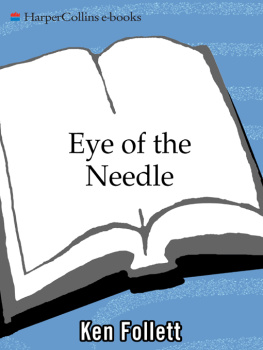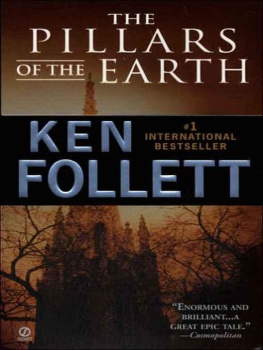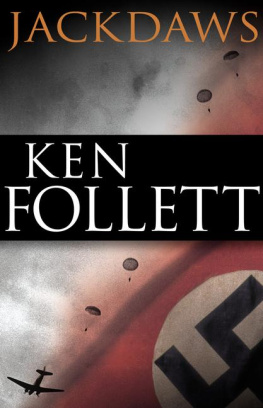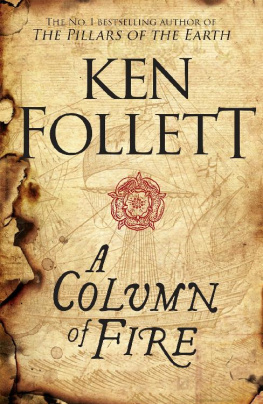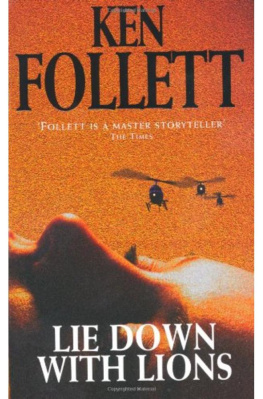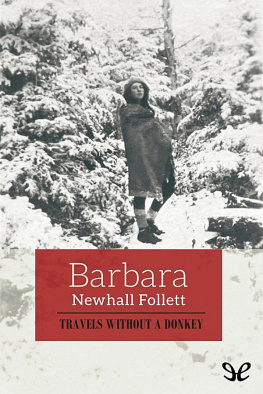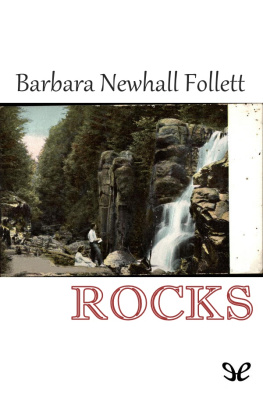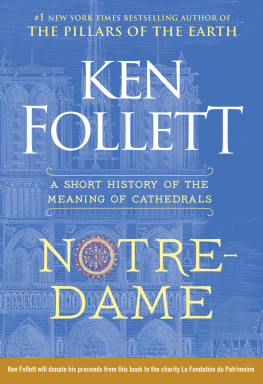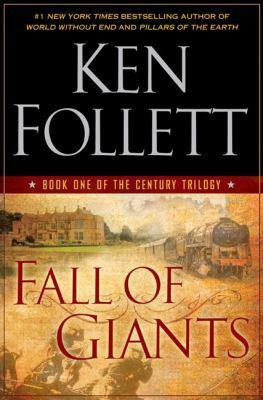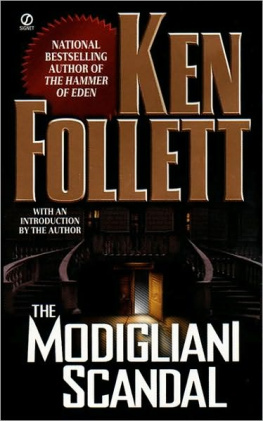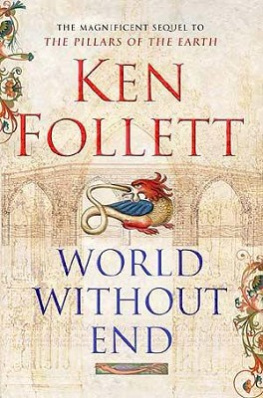Ken Follett - Eye of the Needle
Here you can read online Ken Follett - Eye of the Needle full text of the book (entire story) in english for free. Download pdf and epub, get meaning, cover and reviews about this ebook. year: 2007, publisher: HarperCollins, genre: Art. Description of the work, (preface) as well as reviews are available. Best literature library LitArk.com created for fans of good reading and offers a wide selection of genres:
Romance novel
Science fiction
Adventure
Detective
Science
History
Home and family
Prose
Art
Politics
Computer
Non-fiction
Religion
Business
Children
Humor
Choose a favorite category and find really read worthwhile books. Enjoy immersion in the world of imagination, feel the emotions of the characters or learn something new for yourself, make an fascinating discovery.
- Book:Eye of the Needle
- Author:
- Publisher:HarperCollins
- Genre:
- Year:2007
- Rating:3 / 5
- Favourites:Add to favourites
- Your mark:
- 60
- 1
- 2
- 3
- 4
- 5
Eye of the Needle: summary, description and annotation
We offer to read an annotation, description, summary or preface (depends on what the author of the book "Eye of the Needle" wrote himself). If you haven't found the necessary information about the book — write in the comments, we will try to find it.
Eye of the Needle — read online for free the complete book (whole text) full work
Below is the text of the book, divided by pages. System saving the place of the last page read, allows you to conveniently read the book "Eye of the Needle" online for free, without having to search again every time where you left off. Put a bookmark, and you can go to the page where you finished reading at any time.
Font size:
Interval:
Bookmark:

EARLY IN 1944 German Intelligence was piecing together evidence of
IT WAS THE COLDEST WINTER FOR FORTY-FIVE YEARS. Villages in
HENRY II WAS A REMARKABLE KING. IN AN AGE WHEN
FABERGODLIMANTWO-THIRDS OF A TRIANGLE that one day would
FOREIGNERS HAVE SPIES; BRITAIN HAS MILITARY Intelligence. As if that
IT IS FOR PLACES LIKE THIS THAT THE WORD BLEAK
IT LOOKED LIKE A MANSION, AND, UP TO A POINT,
THE MESSAGE ANNOYED FABER BECAUSE IT FORCED him to face
I THINK WEVE LOST CONTROL OF IT, SAID PERCIVAL Godliman.
THE SUPPLY BOAT ROUNDED THE HEADLAND AND chugged into the
GODLIMAN AND BLOGGS WALKED SIDE BY SIDE ALONG the pavement
FABER HAD GONE FISHING.
THE JU-52 TRIMOTOR TRANSPORT PLANE WITH swastikas on the wings
FABER LEANED AGAINST A TREE, SHIVERING, AND THREW up. Then
FREDERICK BLOGGS HAD SPENT AN UNPLEASANT afternoon in the countryside.
THE CARRIAGE WAS PITCH DARK. FABER THOUGHT OF the jokes
PERCIVAL GODLIMAN HAD BROUGHT A SMALL CAMP bed from his
FABER CROSSED THE SARK BRIDGE AND ENTERED Scotland shortly after
THE U-505 WHEELED IN A TEDIOUS CIRCLE, HER powerful diesels
WHEN LUCY WOKE UP, THE STORM THAT HAD BROKEN the
RERCIVAL GODLIMAN HAD BY NOW PULLED OUT ALL the stops.
WHEN FABER WOKE UP IT WAS ALMOST DARK. THROUGH the
BLOGGS DROVE DANGEROUSLY FAST THROUGH THE night in a commandeered
FABER WAS AWAKE. HIS BODY PROBABLY NEEDED sleep despite the
ERWIN ROMMEL KNEW FROM THE START THAT HE WAS going
THE COTTAGE WAS TERRIBLY SMALL, LUCY REALIZED quite suddenly. As
SID CRIPPS LOOKED OUT OF THE WINDOW AND CURSED under
CIGARETTE TOBACCO BURNS AT 800 DEGREES CENTIGRADE. However, the coal
PERCIVAL GODLIMAN FELT REFRESHED, DETERMINED, evenrare for himinspired.
LYING ON ITS SIDE, THE JEEP LOOKED POWERFUL BUT helpless,
THE WIDE WHITE AUTOBAHN SNAKED THROUGH THE Bavarian valley up
LUCY WOKE UP SLOWLY. SHE ROSE GRADUALLY, languidly, from the
THATS THE PLACE, NUMBER ONE, THE CAPTAIN SAID, and lowered
LUCY WAS BECOMING QUITE CALM. THE FEELING CREPT over her
LUCYS DISTRESS CALL WAS HEARD BY THE CORVETTE.
FABER CLOSED THE DOOR OF THE JEEP AND BEGAN walking
PERCIVAL GODLIMAN HAD A HEADACHE FROM TOO many cigarettes and
THE SOUND OF BREAKING GLASS, THEN AN EXPLOSION like an
HITLER STOOD AT THE PANORAMIC WINDOW, LOOKING out at the
WHEN GERMANY DEFEATED ENGLAND IN THE QUARTER-FINAL of the 1970
The Germans were almost completely deceivedonly Hitler guessed right, and he hesitated to back his hunch
A. J. P. Taylor
English History 19141945
E ARLY IN 1944 German Intelligence was piecing together evidence of a huge army in southeastern England. Reconnaissance planes brought back photographs of barracks and airfields and fleets of ships in the Wash; General George S. Patton was seen in his unmistakable pink jodhpurs walking his white bulldog; there were bursts of wireless activity, signals between regiments in the area; confirming signs were reported by German spies in Britain.
There was no army, of course. The ships were rubber-and-timber fakes, the barracks no more real than a movie set; Patton did not have a single man under his command; the radio signals were meaningless; the spies were double agents.
The object was to fool the enemy into preparing for an invasion via the Pas de Calais, so that on D-Day the Normandy assault would have the advantage of surprise.
It was a huge, near-impossible deception. Literally thousands of people were involved in perpetrating the trick. It would have been a miracle if none of Hitlers spies ever got to know about it.
Were there any spies? At the time people thought they were surrounded by what were then called Fifth Columnists. After the war a myth grew up that MI5 had rounded up the lot by Christmas 1939. The truth seems to be that there were very few; MI5 did capture nearly all of them.
But it only needs one
It is known that the Germans saw the signs they were meant to see in East Anglia. It is also known that they suspected a trick, and that they tried very hard to discover the truth.
That much is history. What follows is fiction.
Still and all, one suspects something like this must have happened.
Camberley, Surrey, June 1977
I T WAS THE COLDEST WINTER FOR FORTY-FIVE YEARS. Villages in the English countryside were cut off by the snow and the Thames froze over. One day in January the Glasgow-London train arrived at Euston twenty-four hours late. The snow and the blackout combined to make motoring perilous; road accidents doubled, and people told jokes about how it was more risky to drive an Austin Seven along Piccadilly at night than to take a tank across the Siegfried Line.
Then, when the spring came, it was glorious. Barrage balloons floated majestically in bright blue skies, and soldiers on leave flirted with girls in sleeveless dresses on the streets of London.
The city did not look much like the capital of a nation at war. There were signs, of course; and Henry Faber, cycling from Waterloo Station toward High-gate, noted them: piles of sandbags outside important public buildings, Anderson shelters in suburban gardens, propaganda posters about evacuation and Air Raid Precautions. Faber watched such thingshe was considerably more observant than the average railway clerk. He saw crowds of children in the parks, and concluded that evacuation had been a failure. He marked the number of motor cars on the road, despite petrol rationing; and he read about the new models announced by the motor manufacturers. He knew the significance of nightshift workers pouring into factories where, only months previously, there had been hardly enough work for the day shift. Most of all, he monitored the movement of troops around Britains railway network; all the paperwork passed through his office. One could learn a lot from that paperwork. Today, for example, he had rubber-stamped a batch of forms that led him to believe that a new Expeditionary Force was being gathered. He was fairly sure that it would have a complement of about 100,000 men, and that it was for Finland.
There were signs, yes; but there was something jokey about it all. Radio shows satirized the red tape of wartime regulations, there was community singing in the air raid shelters, and fashionable women carried their gas masks in couturier-designed containers. They talked about the Bore War. It was at once larger-than-life and trivial, like a moving picture show. All the air raid warnings, without exception, had been false alarms.
Faber had a different point of viewbut then, he was a different kind of person.
He steered his cycle into Archway Road and leaned forward a little to take the uphill slope, his long legs pumping as tirelessly as the pistons of a railway engine. He was very fit for his age, which was thirty-nine, although he lied about it; he lied about most things, as a safety precaution.
He began to perspire as he climbed the hill into High-gate. The building in which he lived was one of the highest in London, which was why he chose to live there. It was a Victorian brick house at one end of a terrace of six. The houses were high, narrow and dark, like the minds of the men for whom they had been built. Each had three stories plus a basement with a servants entrancethe English middle class of the nineteenth century insisted on a servants entrance, even if they had no servants. Faber was a cynic about the English.
Font size:
Interval:
Bookmark:
Similar books «Eye of the Needle»
Look at similar books to Eye of the Needle. We have selected literature similar in name and meaning in the hope of providing readers with more options to find new, interesting, not yet read works.
Discussion, reviews of the book Eye of the Needle and just readers' own opinions. Leave your comments, write what you think about the work, its meaning or the main characters. Specify what exactly you liked and what you didn't like, and why you think so.

